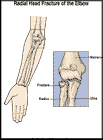
Radial Head Fracture of the Elbow
What is a radial head fracture of the elbow?
Three arm bones come together at your elbow. They are the:
- humerus (the upper arm bone).
- ulna (the larger forearm bone on the little finger side). The end (or head) of the ulna is the "point" of your elbow.
- radius (the smaller forearm bone on the thumb side). The end of the radius is called the radial head. The radial head is the part of the elbow joint.
A fracture is a break in a bone. A radial head fracture may be in the elbow joint or just outside the elbow joint. The break may be:
- straight (also called non-displaced or Type I)
- crooked (called displaced or Type II)
- broken in many pieces (comminuted or Type III).
How does it occur?
A radial head fracture usually occurs from a fall on an outstretched arm. It can also occur from a direct blow to the elbow.
What are the symptoms?
Symptoms include:
- pain on the thumb side of the elbow
- swelling
- difficulty bending or straightening the elbow
- difficulty rotating your forearm (turning your palm up and down)
How is it diagnosed?
Your health care provider will examine your elbow to check where it is tender. You will have an x-ray taken. Sometimes a small break in the radius doesn't show up on the first x-ray.
How is it treated?
A Type I (straight) radial head fracture may be treated with a sling or a splint for a few days until there is no pain. You can then begin doing the rehabilitation exercises given to you by your provider.
If you have a large Type I fracture or a Type II or III fracture, you will have to keep your arm from moving for a longer time. The doctor may have you wear a cast, splint, or sling. Sometimes surgery is needed.
In some cases, even after the fracture heals, your elbow may feel stiff and you may not be able to fully straighten your elbow. Exercises will help you gain back as much range of motion and strength as possible. Your provider will tell you when you can begin elbow exercises.
When can I return to my sport or activity?
The goal of rehabilitation is to return you to your sport or activity as soon as is safely possible. If you return too soon you may worsen your injury, which could lead to permanent damage. Everyone recovers from injury at a different rate. Return to your sport or activity will be determined by how soon your elbow recovers not by how many days or weeks it has been since your injury occurred. In general, the longer you have symptoms before you start treatment, the longer it will take to get better.
You may return to your sport or activity when your elbow has full range of motion without pain and has the same strength as the uninjured side.

